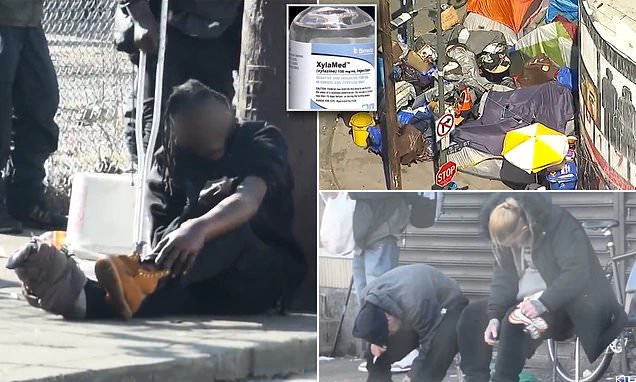Los Angeles officials are trying to stop the spread of the flesh-eating drug xylazine – also known as ‘the zombie drug’ – that has taken over the city
The DEA and the county’s health department have both issued urgent warnings against the use of the drug.
‘When combined with opioids like fentanyl, as is frequently the case, xylazine enhances the life-threatening effect of respiratory depression (slowing or stopping breathing) caused by opioids, increasing the risk of overdose and death,’ county officials said.
Tracking the drug, officials say, will allow them to get a sense of just how bad the problem is and the best practices to cut it out.
Nurses have described the wounds caused by xylazine as appearing as though something is ‘eating away your flesh from the inside out’.
Various liberal politicians and city leaders have attempted to implement numerous policies to curb the many issues that have arisen due to the swelling homeless and drug-addicted population.
One specific harm reduction policy that failed was the opening of the Tenderloin Center in San Francisco last year – a facility that was meant to help alleviate the city’s drug and homelessness crisis.
It cost taxpayers a whopping $22million and was meant to be a ‘safe place’ for addicts to ‘get high without getting robbed’ and without fear of fatally overdosing.
Users were also meant to be directed to help centers, though during its first four months of operations, it referred just 18 people of the more than 23,000 who were welcomed to the site.
Xylazine is now flooding the illicit US drug market, with drug dealers cutting everything from cocaine to heroin with the powerful sedative
A DEA study published in December and involving 60,000 US adult drug tests showed xylazine was detected in samples from 48 out of 50 states in the US
Overall, less than 1 percent of visits to the Tenderloin Center ended in a ‘completed linkage’ to behavioral health programs.
Despite their efforts, 2022 saw upward of 500 people die from overdoses in San Francisco. In 2021, that figure was 641.
Officials had also hoped the site would offer a place to deal with the homeless crisis the city has faced in recent months and years.
San Francisco Mayor London Breed had originally allocated just $10million for the project but it quickly ballooned to more than double that estimate.
In total, some 400 individuals were provided with assistance each day at the center, according to the San Francisco Department of Public Health.
A large portion of those who took advantage of the site used it specifically for shelter or food.
The homelessness crisis in San Francisco is bolstered by the ongoing fentanyl crisis. The synthetic drug is taken by a significant portion of the city’s homeless population and had worked its way into the public drug stream, imperiling teenagers and others across the city.
Fentanyl, a synthetic opioid many times more powerful than heroin, is often mixed with cocaine and other stimulants and consumed unknowingly by recreational drug users.
After the number of US deaths related to overdoses linked to synthetic opioids climbed to 70,000 last year, public health officials continue to sound the alarm over the extremely potent nature of the drug.
Homeless people are seen in Tenderloin district of San Francisco
Summer 2022 in San Francisco. Homelessness has increased markedly in SF over the last few years
Overdose deaths have skyrocketed over the last three years, rising by 50 percent from 52,000 in 2016 to 106,000 in 2021.
The White House attributed the majority to fentanyl poisoning or overdose, and say the drug comes almost entirely from China via Mexico, with a handful of cartels responsible for bringing them across the border.
Six out of 10 fake prescription pills tested by the DEA in 2022 contained fentanyl, and the ‘vast majority’ came from the Sinaloa and Jalisco Cartels.
For years, the synthetic drug had been used as a cheaper, more readily available substitute for heroin. Now though, it is being chopped up with cocaine, MDMA and packed into pills too.
The problems are deeper than simply drugs, of course, as California is by far the worst hit by the nation’s homelessness crisis.
It has about a third of all the country’s homeless people, and Los Angeles, San Jose, Oakland and other Golden State cities have among the largest numbers of unsheltered people in the country.
The US Department of Housing and Urban Development says 582,462 people did not have a permanent home on a single night in January last year when researchers carried out their most recent snapshot survey.
Some 60 percent of the destitute were in shelters, crashing with friends or relatives, or had other temporary digs. The rest were ‘unsheltered’ — sleeping in cars, on the streets or in derelict buildings.
About a third of the entire US homeless population 171,521 people are in California. That includes more than half of the country’s unsheltered homeless population, 115,491 people.
Deaths caused by fentanyl in the US surged in the 2010s. At the start of the decade, 2,666 Americans died of a fentanyl overdose. This figure shot up to 19,413 by 2016. Covid made the situation worse, with a record 72,484 deaths recorded in 2021.
